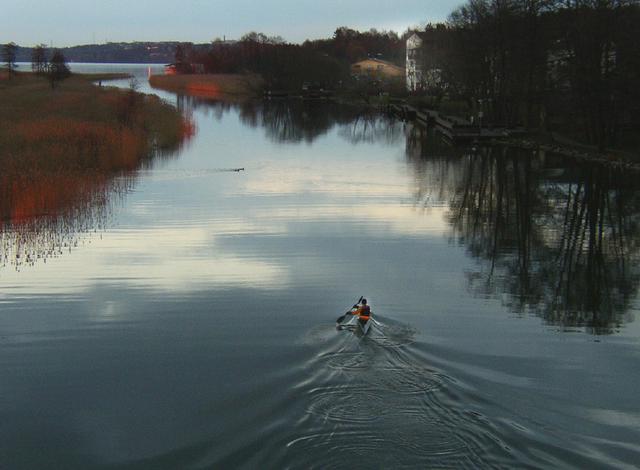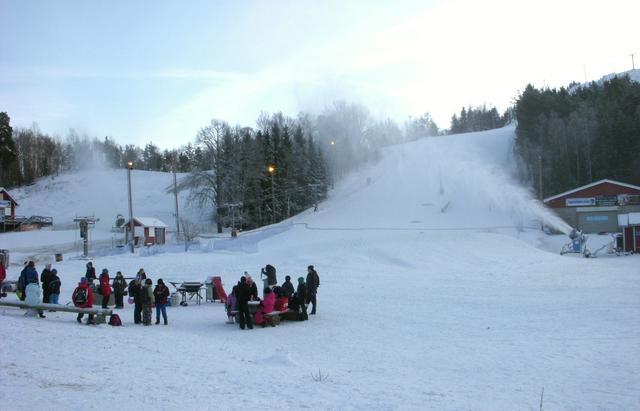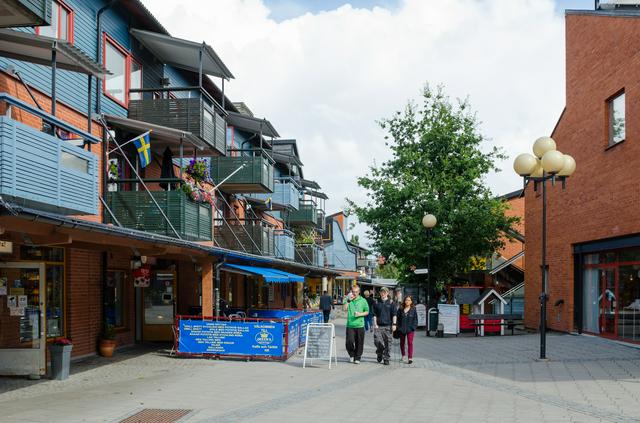Ekerö [ˈeːkərˈøː] is a freshwater archipelago in lake Mälaren, which forms a municipality in Stockholm County. Ekerö is also the only Swedish municipality with two UNESCO World Heritage Sites: Viking age settlement Birka, and Drottningholm Palace, which is the residence of the Royal family.
 During the Ice Age, Nordic bedrock was pushed down, and since the ice melted around 8000 BC it slowly ascends, in Stockholm at the rate of 0.5 centimetres per year (see Nordic countries#Understand). The islands of Ekerö rose above sea level about 1000 BC. around AD 1000, Birka and Adelsö were important centres of commerce, and the water was still part of the brackish Baltic Sea. In the 13th century, as the straits around Stockholm have become narrow enough to make Mälaren a freshwater lake, Stockholm became the natural point of transfer between domestic and international ship transport. The main island Lovön became royal property in the 16th century, housing the Drottningholm Palace, and a number of royal manors. Ekerö and Stenhamra were villages, and grew to suburbs of Stockholm in the 1970s. Though the proximity to Stockholm, farms and forests still dominate the islands.
During the Ice Age, Nordic bedrock was pushed down, and since the ice melted around 8000 BC it slowly ascends, in Stockholm at the rate of 0.5 centimetres per year (see Nordic countries#Understand). The islands of Ekerö rose above sea level about 1000 BC. around AD 1000, Birka and Adelsö were important centres of commerce, and the water was still part of the brackish Baltic Sea. In the 13th century, as the straits around Stockholm have become narrow enough to make Mälaren a freshwater lake, Stockholm became the natural point of transfer between domestic and international ship transport. The main island Lovön became royal property in the 16th century, housing the Drottningholm Palace, and a number of royal manors. Ekerö and Stenhamra were villages, and grew to suburbs of Stockholm in the 1970s. Though the proximity to Stockholm, farms and forests still dominate the islands.
While the natural sceneries are pleasant in themselves, Ekerö has an impressive cultural heritage, with Sweden's first city, and the residence of the Royal family.
Drottningholm Palace. While the Royal Palace is in Stockholm's Old Town, the Royal family lives at Drottningholm Palace on the Lovön island in Lake Mälaren. The 18th-century palace is beautiful, and much of it is open to the public. The surroundings are well worth a walk as well. Travel to T Brommaplan, change to bus 176 or 177 or (mostly during peak hours) 301-336, to Drottningholm. In the summertime, there is also regular boat service from Stadshuskajen (the City Hall Quay) to Drottningholm operated by Strömma Kanalbolaget (130 kr for a return ticket). Consider the combination return ferry ticket (210 kr, includes the palace and the Chinese Pavilion). But, if you are a student with an ISIC card, don't buy the combo ticket because you won't get the discounts offered by the Palace and Chinese Pavilion. There are no interpretative signs in the Palace or in the Chinese Pavilion. So, catch a (free) guided tour, offered nearly every half hour in Swedish and English, and you'll get a lot more out of it. Or, buy a guide book (50 kr). If you use Talk of the town the mobile audioguide for Stockholm. You can listen at six sights spread over Drottningholm Royal domain in six languages.
_4-aMtvQ.medium.jpg) Birka. — For the real Viking buff, there's Birka, the site of a former city of about 1,000 inhabitants situated on Björkö, an island in Lake Mälaren. The city had its heyday during the Viking Age, from AD 700 to AD 1100. As the Vikings were Scandinavians who travelled overseas for commerce, colonization, raiding or mercenary adventures, the citizens of Birka were by definition not Vikings. However, it was probably Sweden's first city, and Vikings and other travellers brought foreign artifacts and ideas, such as Christianity.
Birka. — For the real Viking buff, there's Birka, the site of a former city of about 1,000 inhabitants situated on Björkö, an island in Lake Mälaren. The city had its heyday during the Viking Age, from AD 700 to AD 1100. As the Vikings were Scandinavians who travelled overseas for commerce, colonization, raiding or mercenary adventures, the citizens of Birka were by definition not Vikings. However, it was probably Sweden's first city, and Vikings and other travellers brought foreign artifacts and ideas, such as Christianity.
Since most buildings were made of wood, traces of the settlement are hard to spot, and the most prominent "old" structure is a stone cross from the 19th century; a 1,000-year memorial of the advent of Christianity. The small museum (+46 8 56051445, closed during winter) is really only worth the ride if you are genuinely interested in the subject. Parts of the settlement have been reconstructed.
Boats to Björkö are operated by Strömma Kanalbolaget. Birka can also be reached by taking the green line of the underground (T-Bana) to Brommaplan and from there suburban bus 312 to Rastaholm. Once at Rastaholm, walk down the road to your left for 800 m and you'll find yourself at an inn and a jetty. From here, boats depart for Birka at 10:15, 11:00 or 11:30 depending on the season (see timetable), taking 15-30 minutes to reach Birka.
During the summer, there are several staged events (fairs, archaeology expos etc) at Birka.
- Adelsö., the neighbour of Björkö, contains more archaeological sites than Björkö does, with continuity to the Middle Ages. Hovgården on Adelsö is also a part of the Birka World Heritage Site.

- Outdoor bathing and hiking throughout the area. Rod fishing in Mälaren is unrestricted, see Right to access.
- Drottningholm Palace Theatre. Stages international classics.
- Golf: Drottningholm Golf Club, Mälarö GK, and Troxhammar GK
- Ekebyhov. An alpine skiing slope 2 km east of the Ekerö town, with ski rental and a café. Good for a hike any time of the year.
Drottningholm Palace Theatre. Stages international classics.
[[Golf]]: Drottningholm Golf Club, Mälarö GK, and Troxhammar GK
Ekebyhov. An [[alpine skiing]] slope 2 km east of the Ekerö town, with ski rental and a café. Good for a hike any time of the year.

- Ekerö centrum. A suburban shopping square with basic services such as pharmacy, hairdresser, dentist and liquor store.
- Several farmers' markets.
- Several art studios across Ekerö.
Ekerö centrum. A suburban shopping square with basic services such as pharmacy, hairdresser, dentist and liquor store.
- Drottningholms slottscafé.
- Brostugan.
- Ekebyhov Palace. Lunch buffet during weekdays.
Drottningholms slottscafé.
Brostugan.
Ekebyhov Palace. Lunch buffet during weekdays.
